This hearty beef casserole with suet dumplings is a warming, winter stew at its best. The meat is slow cooked until it is mouth-wateringly tender, while the suet dumplings are light and fluffy, and perfect for soaking up all the delicious gravy.
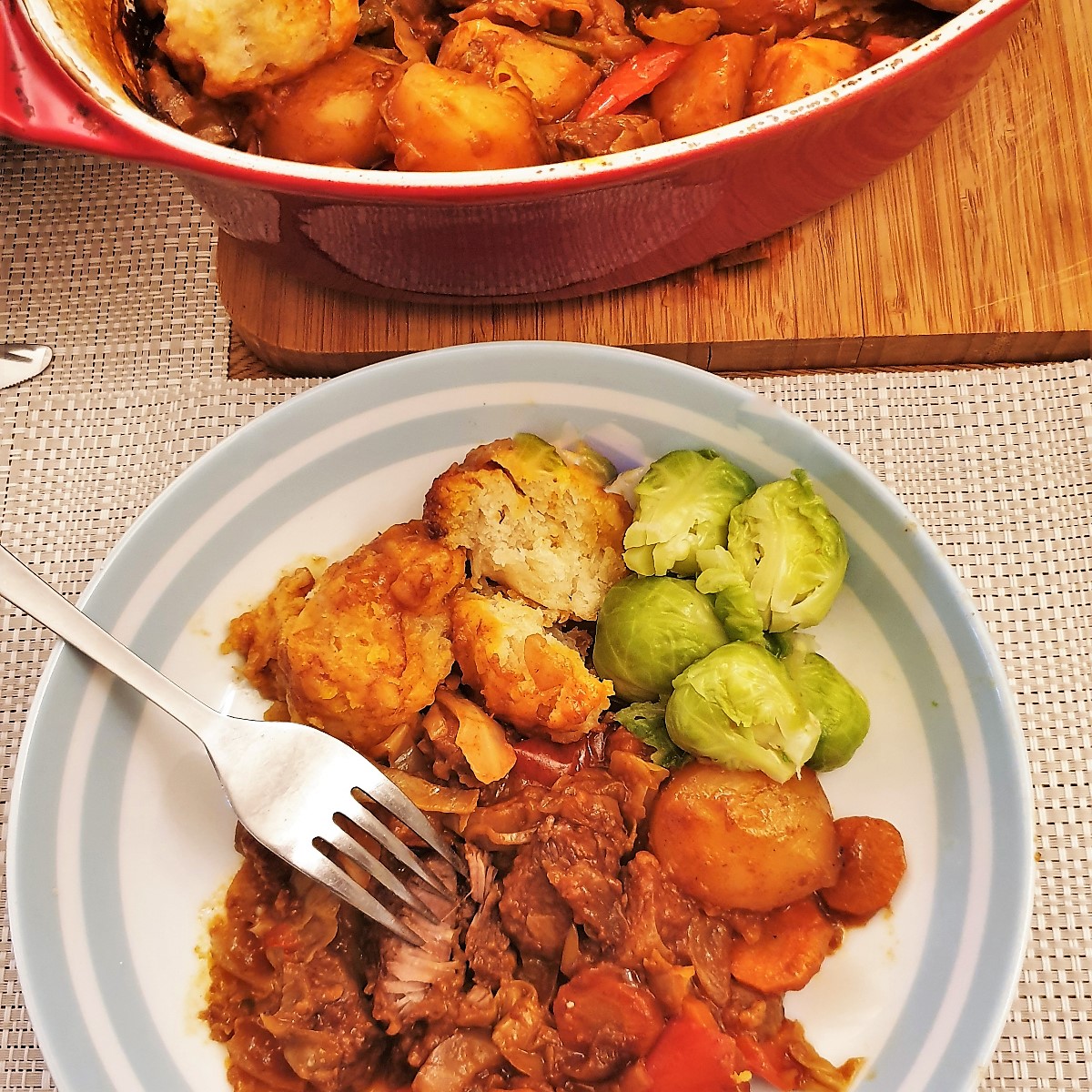
**As an Amazon affiliate, I earn from qualifying purchases.**
Jump to:
Hearty beef casserole with suet dumplings
When you grow up in the north of England (as I did), you will know that hearty comfort foods such as stews and casseroles form a big part of the diet. There's nothing more comforting to come home to on a cold winter's evening than a bowl of steaming beef casserole, with fluffy dumplings floating on the top.
That's why, even though we are still at the tail end of summer here in the UK, when we had a cold snap the other day, I couldn't resist resurrecting my recipe for beef casserole with suet dumplings.
This is comfort food at its finest. Tender chunks of beef, slow braised until you can cut them with a spoon, cooked in a casserole full of delicious vegetables, swimming in thick gravy and topped with fluffy dumplings. This recipe has my name written right across it. So I made it. And Graham had seconds, which is always a good sign 🙂 .
Of course, the fact that I also picked up a big bag of the first crop of brussels sprouts (my all time favourite veg) from the market may have had something to do with my choice of menu. But oh my goodness, it was delicious.
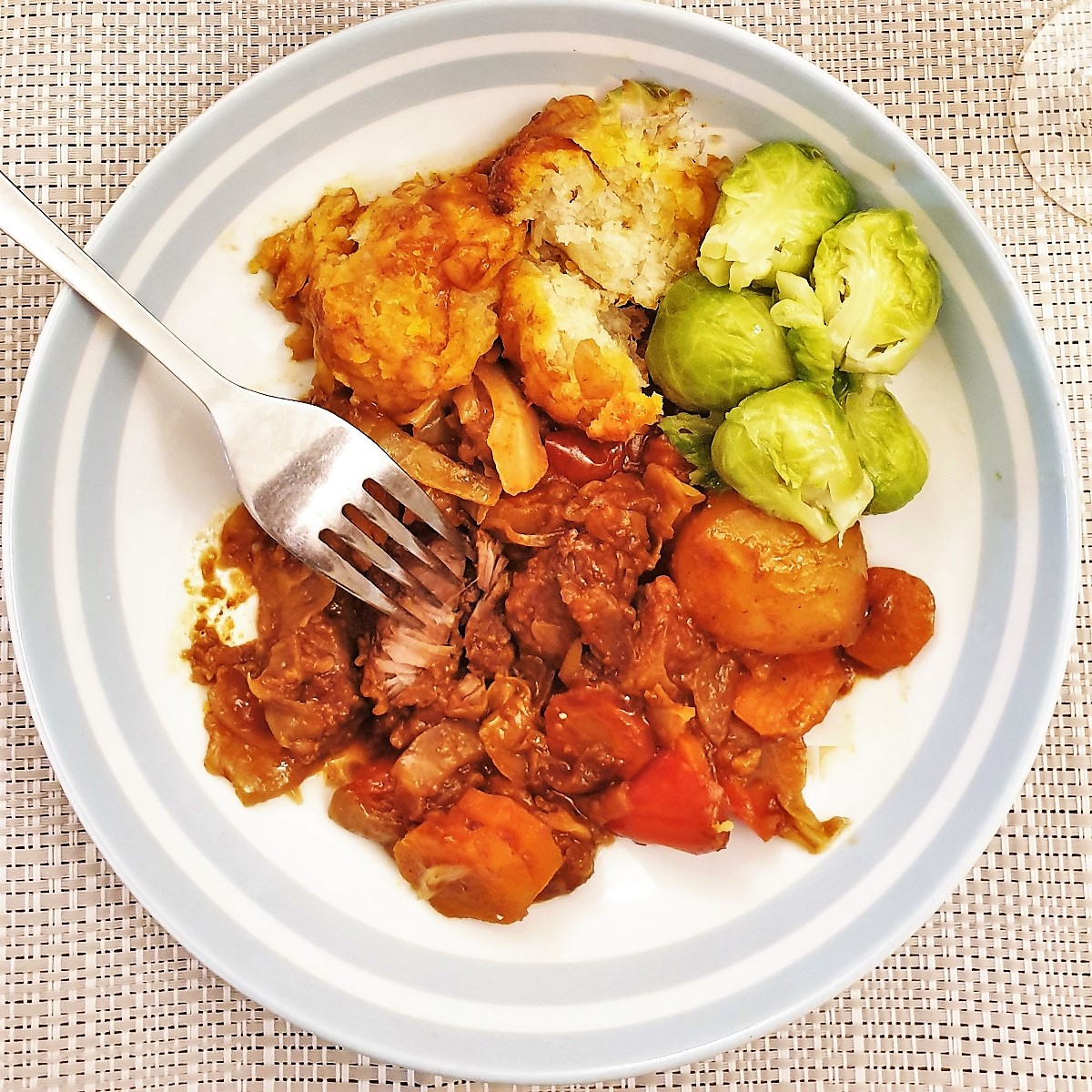
How to make beef casserole with suet dumplings
This dish is easier to make than you might think. There is a bit of prep, then you just pop the casserole dish in the oven and forget about it until it's cooked.
You can get the complete list of ingredients and full instructions on the printable recipe card at the end of this post.
This recipe will easily feed 4 hungry people. However, with this recipe you don't have to be exact with the quantities - just adjust according to your family's appetite.
Preparation
I always find that if I spend a bit of time prepping everything up front, a recipe just falls together. This recipe is no exception.
Cut the meat into bite-sized pieces and coat in a mixture of flour, salt and paprika (image 1 below). I love the flavour of paprika, it gives such a rich flavour to a casserole. Why not try my recipe for Hungarian goulash and see for yourself? I've allowed 150g (5 ounces) of meat per person.
Peel and chop the vegetables. I have used onions, red peppers, celery, carrots, cabbage and potatoes for this casserole, but you can use any combination of your favourite vegetables. Cut the onions, celery and red peppers into approximately 2cm pieces. Slice the carrots into ¼" rings and shred the cabbage finely. Cut the potatoes into quarters.
You should allow between 1 and 1 and a half cups of vegetables per person (excluding the potatoes). For the potatoes, I allowed one medium potato per person.
Mix the gravy so that it is ready when you need it. Dissolve 2 beef stock cubes into 2 cups of boiling water and then add 4 tablespoons of Worcestershire sauce and 3 tablespoons of tomato puree.
Cooking
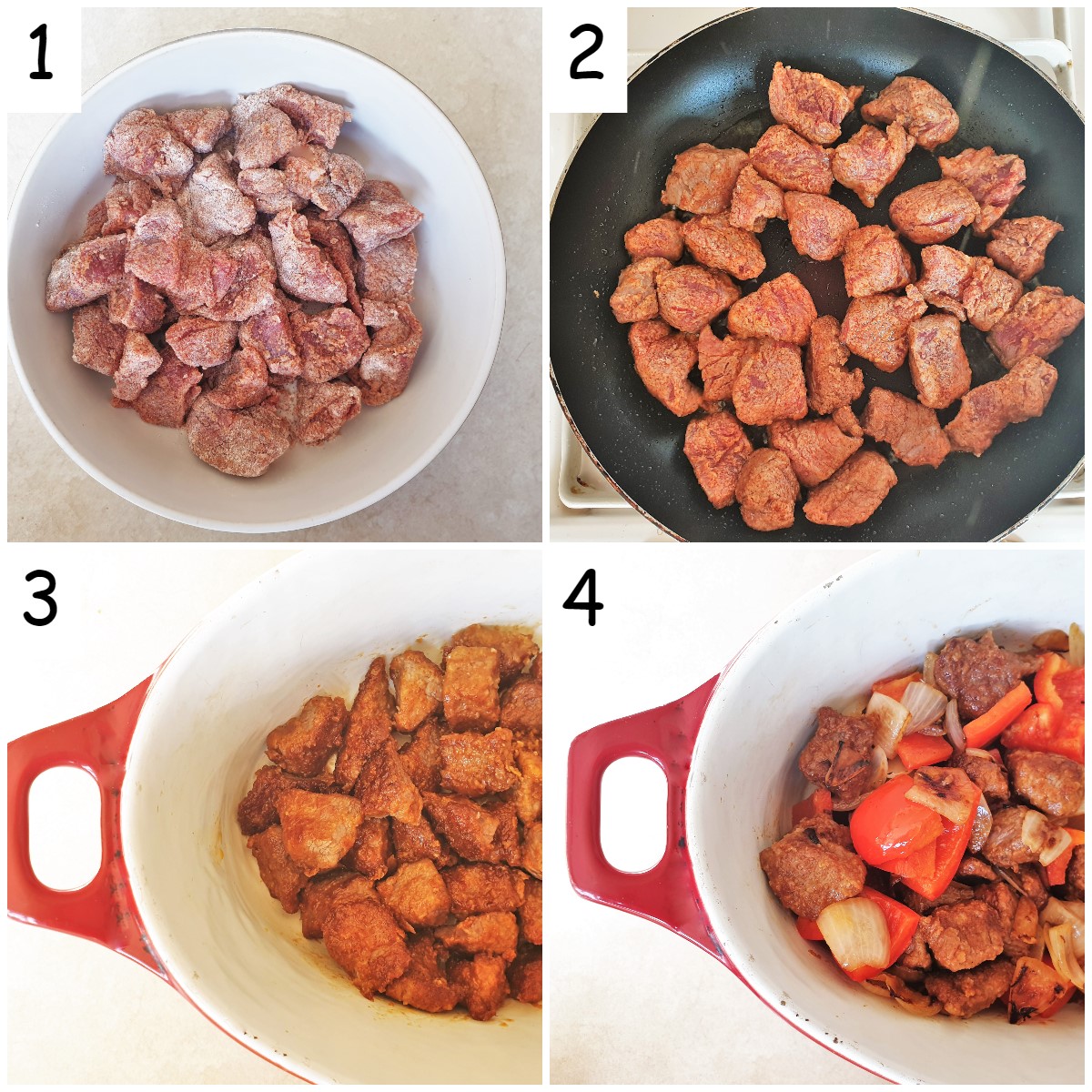
Start off by browning the flour-coated meat (image 2 above). Use a hot pan with 2 or 3 tablespoons of sunflower oil to brown the meat. The meat should just sear on the outside without releasing any of its juices. You don't want the meat to boil. If necessary, brown the meat in batches so that the pan doesn't lose too much heat when you put the meat in.
Tip the browned meat into a casserole dish (image 3 above) and then turn your attention to the onions and red peppers. I like to soften these in the pan that the meat was browned in so that they can pick up any residue from the browned meat. You may need to add another tablespoon of oil to the pan. Once the onions turn translucent, transfer the onions and peppers to the casserole with the meat (image 4 above).
Finally, mix in the remaining chopped vegetables and pour over the stock and half a cup of red wine (image 1 below). I find a small amount of red wine really adds flavour to this dish. If you don't drink alcohol you can substitute this with extra stock.
Cover with a lid tightly fitting lid and place the dish in the oven. Set the temperature at 180C/350F for about 1 hour 45 minutes. You can pre-heat the oven if you want to, but it's not really necessary.
One tip I will give you though is to check halfway through the cooking and make sure that the dish isn't drying out. If the lid on your casserole dish doesn't fit really tightly, you may find that there may be some evaporation which will cause the dish to lose too much liquid. If this happens, just top up with extra stock.
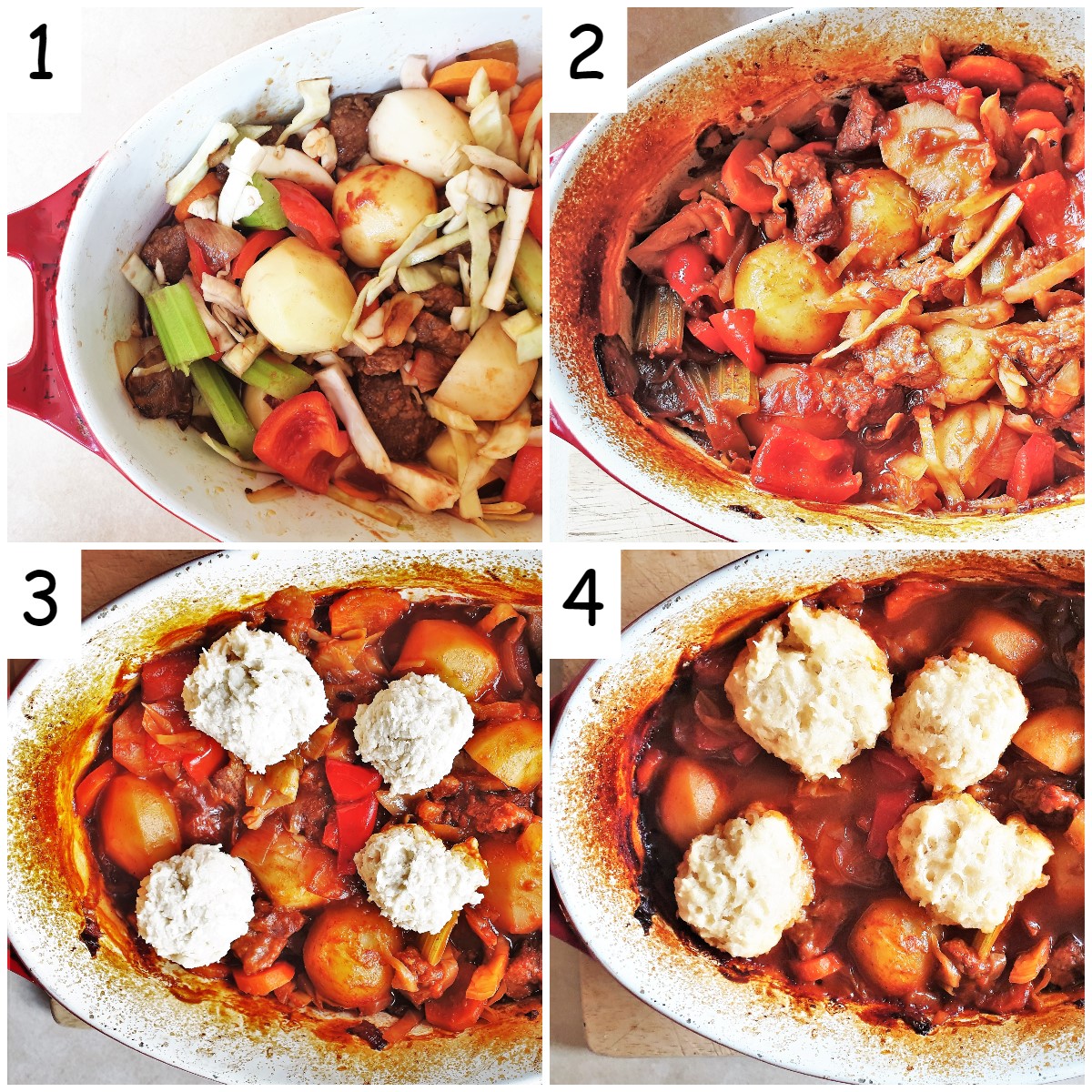
Make the dumplings
While the meat is cooking you can mix the dumplings.
For 8 dumplings you will need about a cup of self-raising flour and ½ a cup of suet. If you live in the US, I believe suet is hard to come by in the supermarkets. I have had a look on Amazon and they stock the brand that I use, which is Atora shredded suet. If you buy it from there you can store it indefinitely in your pantry (just check the sell-by date) so you always have some on hand. This suet is great for making the pastry for my meat and potato pie.
Mix the flour and suet, in a bowl with a teaspoon of salt. If you don't have self-raising flour you can just add a teaspoon of baking powder (or if you live in the US, add half a teaspoon of cream of tartar and a quarter teaspoon of bicarbonate of soda).
If you like herby dumplings you can add a teaspoon or so of Italian herbs with the flour.
Add sufficient water to make a soft, non-sticky dough. You will need about ¼ cup of water, but don't add it all at once. Start off by adding ¾ of the water and adding more if you need it. It depends on how much water the flour absorbs as to how much water you will need.
Also, when working with suet, the suet will not break down into the flour as it would if you were using butter or shortening. There will be lumps of suet in the dough - this is perfectly normal. The suet will melt into the dumplings as they cook, leaving them light and fluffy.
Divide the dough into 8 equal pieces, and roll into golf-ball-sized balls. They will swell slightly when you bake them in the casserole.
After 1 hour and 45 minutes, remove the casserole from the oven, place the dumplings on top, replace the lid and return to the oven for another 15 minutes (images 3 and 4 above).
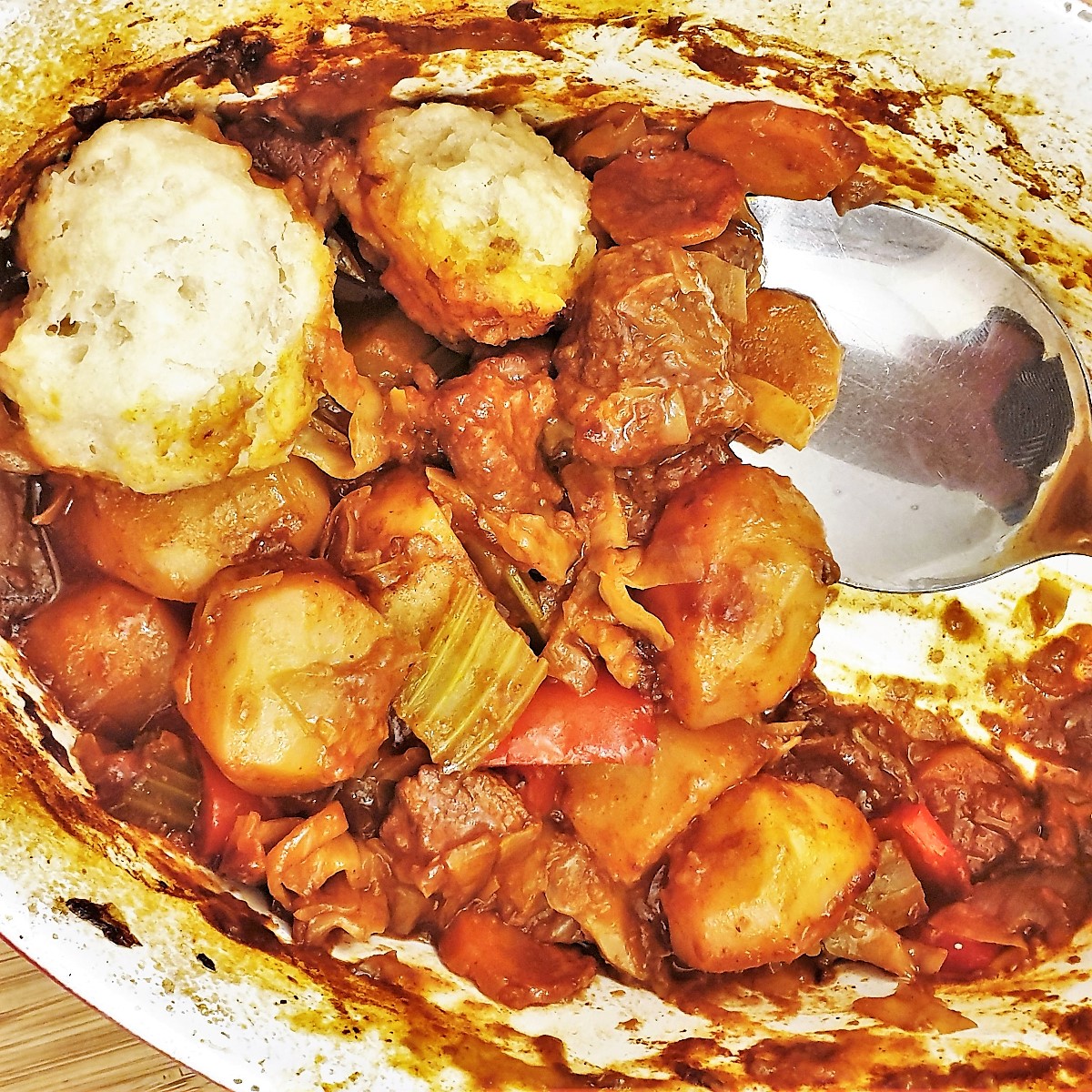
What do I serve with beef casserole?
To be perfectly honest, this stew is a meal in itself. There is plenty of meat and vegetables in this dish, and combined with the dumplings you shouldn't need anything else.
However, that said, I always serve it with a helping of brussels sprouts, firstly because I love them, and secondly to add a bit of colour to the plate!
You could also serve with some crusty bread rolls to mop up any of the delicious juices.
If you'd like to be notified of any new recipes, why not subscribe to my newsletter? As a thank-you gift, you will receive a free recipe e-book containing some of my most popular cakes and desserts.
Can I freeze this beef casserole?
Yes, it freezes well. In fact, there are only two of us at home but I always make enough for 4 and freeze half for another meal.
Remove any leftover dumplings, and freeze the cooled leftover casserole in a rigid plastic container. You can store this in the freezer for up to 3 months.
To reheat, defrost in the fridge and tip into a casserole dish. If there isn't much gravy left, top up with a cup of stock (you can use a stock cube).
Place in a preheated oven (180C/350F) for 10 minutes until the stew is heated through.
Serve with crusty bread in place of the dumplings.
Save for later
Why not pin this recipe for beef casserole with suet dumplings to one of your Pinterest boards so you can find it easily? Just click the image below.
Alternatively, you can save the recipe by clicking on the floating heart icon on the right-hand side of the screen.
Other hearty meals
You may also like these other hearty meals:
- Lancashire hotpot
- Beef Trinchado
- Cheesy garlic bread pasta bake
- Hearty beef cobbler with cheesy scones
📋The recipe
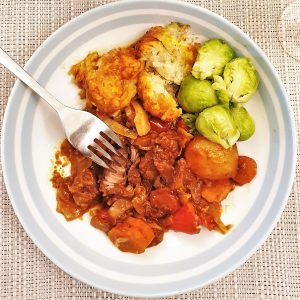
Hearty beef casserole with suet dumplings
(Click the stars to rate this recipe)
Equipment
- Large casserole dish with lid
Ingredients
Beef
- 21 ounce 600g stewing beef
- 2 Tablespoon plain flour
- 2 teaspoon paprika
- 1 teaspoon salt
- 2 - 4 tablespoons sunflower or canola oil for frying the coated beef
Vegetables
- 1 large onion approx 1 cup chopped
- 1 large red pepper approx 1 cup chopped
- 2 large stalks celery approx 1 cup chopped
- 2 medium carrots approx 1 cup sliced
- ¼ small white cabbage approx 1½ cups finely shredded
- 4 medium potatoes quartered
Gravy
- 2 cups beef stock made with stock cubes and boiling water
- ½ cup red wine
- 4 tablespoons worcestershire sauce
- 3 tablespoons tomato puree
Dumplings
- 1 cup (140g) plain all purpose flour
- ½ cup (65g) beef or vegetable suet
- 1 teaspoon baking powder
- ½ teaspoon salt
- 1 teaspoon mixed Italian herbs optional
- ¼ cup water approximately
Instructions
Preparation
- Mix the flour, paprika and salt in a bowl.
- Cut the meat into bite-sized chunks then coat in the flour mixture
- Cut the onions and red peppers into approximately 2 cm pieces
- Cut the celery into 1" lengths
- Slice the carrots into ½" rounds
- Shred the cabbage finely
- Dissolve 2 beef stock cubes in 2 cups boiling water, then stir in 4 tablespoons worcestershire sauce and 3 tablespoons tomato puree
Brown the meat and fry the onions and pepper
- Heat the oil in a large frying pan and brown the flour-coated meat. You should do this over quite a high heat so that the meat sears on the outside. Don't overcrowd the pan - you may need to do this in batches.
- Place the browned meat in a casserole dish.
- Using the same frying pan, sweat the onions and peppers over a low heat until starting to soften. Scrape the pan to incorporate all the bits leftover from browning the meat. You may need to add another tablespoon of oil before adding the onions.
Assemble the casserole and cook
- Pre-heat the oven to 180°C / 350°F
- Add the softened onions and peppers to the meat in the casserole dish
- Add the celery, carrots and cabbage and mix to combine
- Pour in the red wine and the stock mixture
- Cover and place in the centre of the pre-heated oven for 1 hour 45 minutes
Make the dumplings
- Combine all the ingredients for the dumplings (with the exception of the water) in a mixing bowl.
- Gradually mix in the water until the mixture comes together in a soft ball. You may need to use slightly more, or slightly less water. The mixture should not be sticky.
- Divide the dough into 8 equal pieces and form into balls. They will be the approximate size of golf-balls.
- After 1 hour and 45 minutes remove the casserole from the oven and remove the lid.
- Place the dumplings on top of the meat and vegetables. Replace the lid and replace the casserole dish back in the oven for another 15 minutes until the dumplings are cooked and fluffy.
- Remove from the oven and serve.
Notes
Nutrition
I am not a nutritionist. The nutrition information has been calculated using an on-line calculator, and is intended for information and guidance purposes only. If the nutrition information is important to you, you should consider calculating it yourself, using your preferred tool.
If you made this recipe and enjoyed it, I'd love it if you could give me a star rating in the comments below. And if you'd like to get in touch, you can email me at [email protected]. I'd love to hear from you. And don't forget to subscribe to my mailing list so you can grab yourself a copy of my FREE COOKBOOK!
If you'd like to continue browsing, just click on this link to all my recipes.




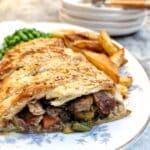

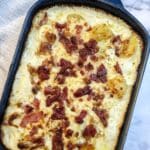

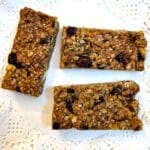
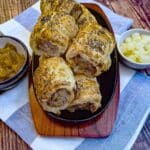

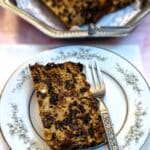
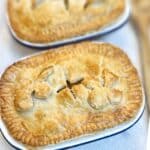

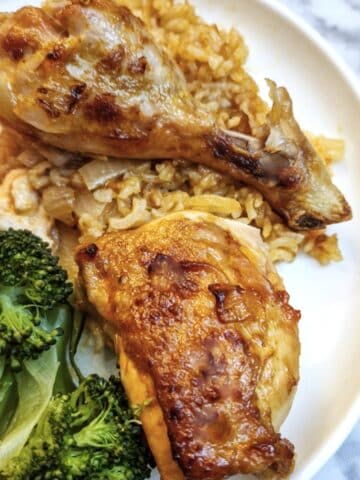
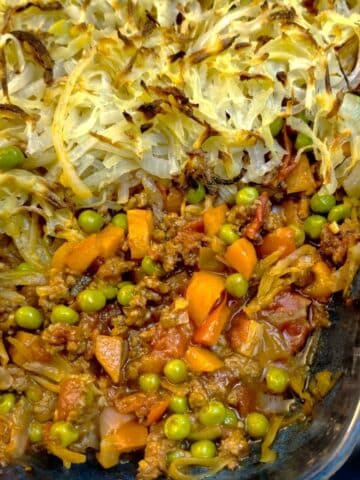
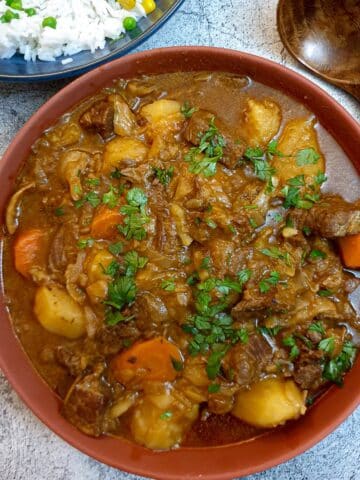
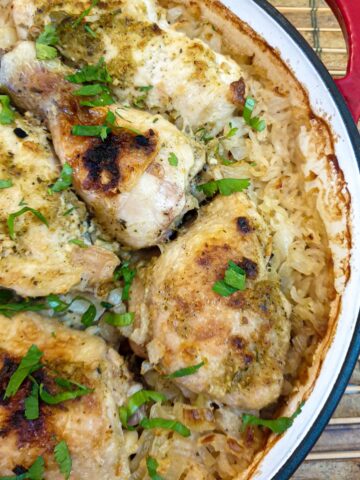
Did you make this recipe? Let me know!